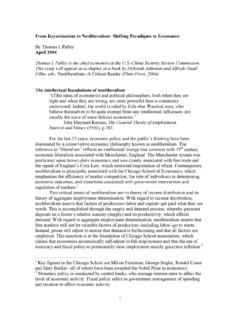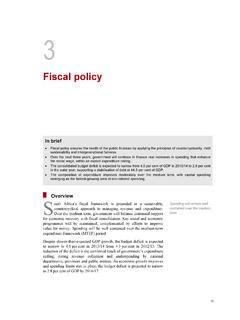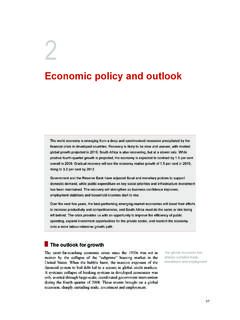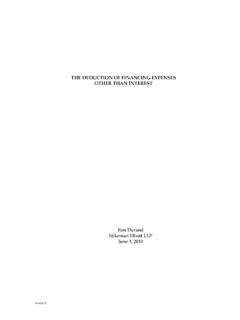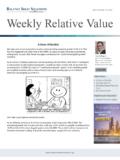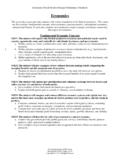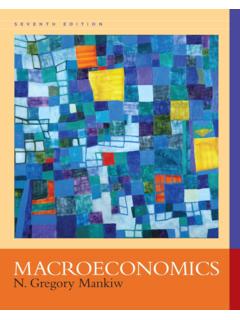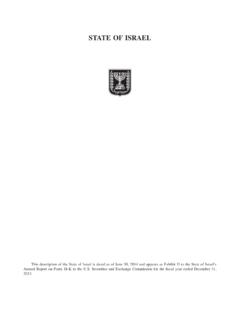Transcription of Money, fiscal policy, and interest rates: A critique …
1 1 money , fiscal policy , and interest rates : A critique of Modern Monetary Theory Abstract This paper excavates the set of ideas known as modern monetary theory (MMT). The principal conclusion is that the macroeconomics of MMT is a restatement of elementary well-understood Keynesian macroeconomics. There is nothing new in MMT s construction of monetary macroeconomics that warrants the distinct nomenclature of MMT. Moreover, MMT over-simplifies the challenges of attaining non-inflationary full employment by ignoring the dilemmas posed by Phillips curve analysis; the dilemmas associated with maintaining real and financial sector stability; and the dilemmas confronting open economies.
2 Its policy recommendations also rest on over-simplistic analysis that takes little account of political economy difficulties, and its interest rate policy recommendation would likely generate instability. At this time of high unemployment, when too many policymakers are being drawn toward mistaken fiscal austerity, MMT s polemic on behalf of expansionary fiscal policy is useful. However, that does not justify turning a blind eye to MMT s oversimplifications of macroeconomic theory and policy . Keywords: modern monetary theory, money financed budget deficits, fiscal policy .
3 JEL reference: E00, E02, E10, E12, E24, E40, E58, E62, E63. Thomas I. Palley Independent Economist Washington, January 2013 I Introduction This paper excavates the set of ideas known as modern monetary theory (MMT). MMT is a collection of thoughts about the origins of money , the source of value of fiat money , and the nature of the financial constraint on government. It also advances a number of policy recommendations regarding use of money financed budget deficits, interest rate policy , and having government act as employer of last resort (ELR). MMT is significantly associated with economists Randall Wray, Stephanie Kelton, and Mathew 2 Forstater of the University of Missouri at Kansas City, along with financier Warren Mosler.
4 Wray (1998) provides the most comprehensive statement of MMT. The principal conclusion of the paper is that the macroeconomics of MMT is a restatement of elementary well-understood Keynesian macroeconomics. There is nothing new in MMT s construction of monetary macroeconomics that warrants the distinct nomenclature of MMT. Moreover, MMT over-simplifies the challenges of attaining non-inflationary full employment by ignoring the dilemmas posed by Phillips curve analysis; the dilemmas associated with maintaining real and financial sector stability; and the dilemmas confronting open economies.
5 This tendency to over-simplify results in poorly conceived policy recommendations, especially for developing countries. Furthermore, MMT policy recommendations take little account of political economy difficulties. At this time of high unemployment, assessing MMT is difficult. On one hand, MMT s policy polemic on behalf of expansionary fiscal policy is very useful at a time when too many policymakers are being drawn toward mistaken fiscal austerity. On the other hand, one should not turn a blind eye to MMT s oversimplifications of macroeconomic theory and policy . II MMT and the origins and value of sovereign fiat money The core of MMT concerns how government issued fiat money ( sovereign fiat money ) relaxes the financial constraint on government and opens space for policy .
6 That places sovereign fiat money at the center of the story. The MMT approach to sovereign fiat money is the Chartalist approach developed by Knapp (1924), which was also accepted by Keynes (1930). Chartalist theory maintains 3 government issued fiat money has value because governments demand taxes be paid in sovereign money , thereby creating public demand This idea that the demand for sovereign money is in part due to the obligation to use it to pay taxes is uncontroversial. For instance, James Tobin (1998, ), one of the foremost neo-Keynesians, writes in his textbook (co-authored with Steven Golub):2 By its willingness to accept a designated asset in settlement of taxes and other obligations, the government makes that asset acceptable to any who have such obligations, and in turn to others who have obligations to them, and so on.
7 However, in addition to accepting the Chartalist explanation of money , Keynes and Tobin also accepted money derives value from its use as medium of exchange, unit of account, and store of value. These features supported the development of money , though money was in turn was captured by governments as part of state building and tax collection. Moreover, these features continue to impact the evolution of money , as reflected in the development of e-monies such as debit cards. From this perspective, state money is one form of money that is in perpetual competition with other forms of money , and the boundary of use fluctuates with legal and technological developments.
8 However, state money is the highest form of money in that it can be used to pay tax obligations and it is also generally acceptable for discharge of private debts. Unfortunately, MMT sets up unnecessary controversy by asserting that the obligation to pay taxes is the exclusive reason for the development of money . Thus, Wray (2012, ) writes dismissively of other arguments regarding the development of money : We all know the usual approach to money , that begins with the fantasized story about barter, the search for an efficient medium of exchange,.. 1 Wray (1998, chapter 2) provides a thorough and concise discussion of Chartalist theory.
9 2 Wray (1998) cites this quote but it is buried in the last footnote (number 16) of his chapter on Chartalism. 4 Indeed, he goes further to claim that the obligation to pay taxes is the only reason for the development of markets: Why did markets develop? Not to barter what you have but don t want, but rather to obtain the means of debt (tax) settlement (ibid., ). The critique of this extreme MMT perspective is succinctly stated by Rochon and Vernengo (2003, ): Sovereignty, understood as the power to tax and to collect in the token of choice, is not the main explanation for the existence of money , even if modern money is ultimately chartal money .
10 In many regards, these differences over the origins of money are peripheral to the main arguments of MMT, especially as all agree state money is Chartal. That said, they reveal two characteristics of MMT that hold for other issues. The first is the tendency to over-simplification. The second is a polemic whereby over-simplified re-statement of theory is represented as if it were new theory through the nomenclature of MMT .3 III MMT and the institutional arrangement between fiscal and monetary authorities The central macroeconomic policy claim of MMT is that sovereign fiat money changes the nature of the financial constraint on government.
